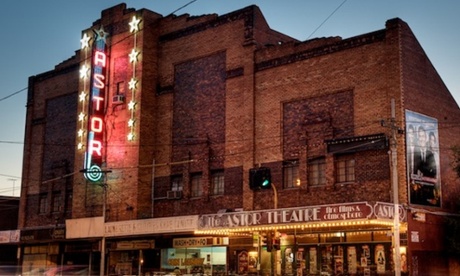
It’s approaching midnight and writer-director Kevin Smith – the fast-talking fanboy-cum-film-maker of slacker comedies Clerks, Mallrats and Chasing Amy – is on stage regaling the audience with his best anecdotes about working in show business.
The year is 2006 and I’m at the Australian premiere of Clerks 2. The post-show Q&A with Smith has gone on for almost three hours (about twice the length of the film) and shows no sign of ending. Smith won’t stop gabbing and the audience, though gradually reducing in numbers, are lapping it up.
The larger-than-life director is in the middle of explaining how he joined the Catholic church to picket against the release of his own movie, Dogma, when he suddenly stops. Somebody in the audience is holding up a hand-drawn sign. He reads it aloud.
“Cinema closing, please wrap up.” Smith pauses for a moment, puts on an expression of mock confusion. “Which cinema?”
This is my favourite memory of Melbourne’s Astor theatre, which for decades has occupied cherished real estate in the hearts of Australian cinephiles – and whose fate is entangled in real estate of the more literal kind. Constructed in 1936, it is a beautiful single screen art-deco venue known and loved for screening cult films, retrospectives and double features of almost exclusively old titles.
Where can you go to see a super high definition 4K digital restoration of Lawrence of Arabia on the big screen? What about a John McTiernan special (Predators followed by Die Hard)? Or Casablanca? Or The Dark Crystal and Labyrinth? Melburnians and cinema lovers from afar have long known the answer: the Astor.
If its eclectic program of classics and cult flicks gets punters in the door, some endearing add-ons increase their likelihood of returning. There’s popcorn and Coke at prices that don’t consume half a week’s pay, a hard-copy calendar that for many years seemed to occupy the back of the toilet door of every film fan in town, and even a friendly cat you used to be able pat on the way in (local legend and social media star Marzipan died last year).
But reality has an annoying habit of encroaching on the magic of the movie business. The Astor’s impending closure, recently announced, will surprise no one following the venue’s own plotline. Behind the scenes, a serious disagreement between the building’s owner and proprietor has lasted for longer than Lawrence’s trek across the desert – resulting in news that the Astor’s curtains will reportedly come down for good in April 2015.
According to reports, proprietor George Florence has been asked to return the building to its original state when he took out the lease, which would mean gutting its screen, projector and fittings. There’s also the fact Florence owns the Astor trademark and will be taking that with him (though he can’t take the sign – at least not without permission – because it’s heritage protected).
Perhaps the most despairing part of negotiations between Florence and the building’s owner Ralph Taranto is that, at one point, a 10-year lease was on the table. According to a Fairfax report, one of the reasons Florence rejected it was because the lease “was too long”.
How could a decade’s contract be too much for such an old and historically significant institution? It says something of the cinema’s presumably grim ledgers – it’s no secret the Astor was struggling financially – as it does the broader culture of movie-going, particularly for venues that don’t rely on drawing crowds by exhibiting the 16th instalment of Pirates of the Caribbean or The Amazing Spider-Man remake #53.
It doesn’t help that the Astor is on the wrong side of the river. A short walk from Chapel Street’s swanky clubs and super expensive clothes shops (not exactly a cosy fit), the cinema would almost certainly fare better northside, where the retro-is-chic-and-damn-Labyrinth-is-a-trippy-movie vibe is stronger. Many locals loved to say they loved the Astor but didn’t necessarily return to vote with their wallets.
A petition was signed by a host of celebrities in 2012, when the Astor’s previous owner, St Michael’s Grammar, floated the idea of redeveloping the building into a performing arts space. The backlash was so intense that the school sold the venue for a price believed to be less than what they paid for it. Taranto was heralded as a “white knight” when he coughed up a few million dollars to buy the Astor; he is now facing accusations that he is responsible for killing it.
The grim fact remains that the cinema operated on a business model wobbly enough when reliant on new produce (the also-loved Greater Union on Russell Street in the CBD, which screened contemporary films, closed in 2013), let alone a place whose line-up consists of movies everybody already owns on DVD. Melbourne’s fledging bar film culture, where small audiences drift into dingy honkytonks on Brunswick Street, High Street and Smith Street, also nipped at the Astor’s heels.
All this is irrelevant in the face of one unassailable truth: venues such as this venerated southside cinema are the film world’s equivalent of endangered species. Perhaps the best we can hope is that the spirits of them are lovingly reincarnated – in loungy corridor-thin bars or venues supplemented by multiple income streams like Melbourne’s government-subsidised ACMI cinema complex.
For now, acknowledging the sombre truth that it was all going to end anyway, friends of the Astor can reflect on the good times. Yeah, those old seats weren’t kind to the spine, but the atmosphere around them was some kind of wonderful.

